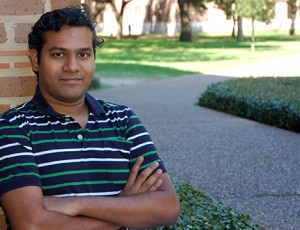 Fourth-year Ph.D. student Hamim Zafar’s research continues to lead him into unexpected areas of focus. While completing an undergraduate degree in Electronics and Telecommunications in Calcutta, he was working with a professor on optimization problems. “That was more computer science,” he said, “even though it was mainly being used in different engineering fields.”
Fourth-year Ph.D. student Hamim Zafar’s research continues to lead him into unexpected areas of focus. While completing an undergraduate degree in Electronics and Telecommunications in Calcutta, he was working with a professor on optimization problems. “That was more computer science,” he said, “even though it was mainly being used in different engineering fields.”
Zafar switched his focus to CS, and applied to graduate programs in the United States. He said, “I chose Rice because of its rank and for the opportunities I would have here.” Then he grew to appreciate the serenity of Rice. “What I like best about Rice is its community,” he said. “Because the department is small, everyone knows everyone else. Professors know the students personally, grad courses have only about 20 students in them, and we get to pursue the directions we want.”
In his first year of graduate study, his goal was to work closely with the researchers in areas of artificial intelligence (AI), machine learning, and similar problems. “Almost at the end of my first semester, I met Luay,” Zafar said. CS professor Luay Nakhleh’s Bioinformatics Group conducts research into developing methodologies/algorithms, implementing software tools and conducting analyses to answer biological questions.
“I was reading through his papers and found one where he was using a method I had used, and I realized bioinformatics research was a possibility.” Nakhleh gave Zafar small problems to work on during the winter break, they began working together the next semester, and then prepared a paper. This work involved learning Boolean networks from gene expression data.
Nakhleh next introduced Zafar to Dr. Ken Chen at M.D. Anderson. “He put me onto cancer genomics,” said Zafar. “Luay said, ‘this is a very interesting field, very cutting edge research, and we need new algorithms to answer the existing questions,’ which was my interest as well.” Once again, Zafar was reading papers, this time in cancer genomics. Chen gave him two papers and asked Zafar to think about a new method for solving the problem in analyzing single cell sequencing (SCS) data. Zafar said, “Another M.D. Anderson professor, Dr. Nicholas Navin, was a pioneer in the field of SCS. His lab produces a lot of data that records new algorithms to analyze. I was assigned to a project developing a method to predict single nucleotide variants.”
Zafar had never considered cancer research, so in addition to solving algorithmic problems, he was also tackling biology. “Initially, it was completely new to me. I hadn’t been a Bio major! I had to learn it, and also sequencing technology methods, how aspects of that are reflected in the data and of course the state-of-the-art bioinformatics algorithms.”
He successfully navigated a steep learning curve in both areas. “After I developed my method and defended my masters on it, I realized we were probably going to get a good paper out of it, and that researchers around the world would be interested in our work,” he said. Zafar presented his work in Dublin at HiTSeq 2015, where there was a lot of interest in SCS.
HiTSeq is a special interest group meeting conducted at the annual, international conference on Intelligent Systems for Molecular Biology. At the Dublin conference in 2015, Zafar saw different researchers presenting various methods for analyzing SCS data. He said, “Interactions with other researchers showed me that what I am working on is really important in cancer research, to understand cancer biology with potential application in clinical therapy.”
 When their paper, “Monovar: single-nucleotide variant detection in single cells,” was published in Nature Methods in April 2016, Zafar felt it was one of his greatest achievements. Looking back on all he read and learned about biology, cancer, and single cell sequencing in order to follow his passion for solving algorithmic problems, he said simply, “Hard work finally paid off.”
When their paper, “Monovar: single-nucleotide variant detection in single cells,” was published in Nature Methods in April 2016, Zafar felt it was one of his greatest achievements. Looking back on all he read and learned about biology, cancer, and single cell sequencing in order to follow his passion for solving algorithmic problems, he said simply, “Hard work finally paid off.”
Hamim Zafar completed his M.S. in CS in 2015. His adviser is Luay Nakhleh.
